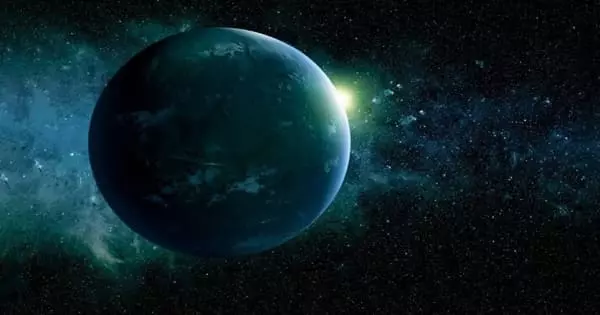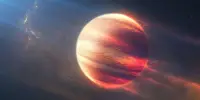Considered an ultra-hot Jupiter a place where iron vaporizes, condenses on the night side, and then falls from the sky like rain, the fiery, inferno-like WASP-76b exoplanet may be even hotter than scientists previously thought.
Rocky planets larger than our own, known as super-Earths, are surprisingly common in our Galaxy and are the most likely to be habitable. Gaining a better understanding of their interior structures will aid in predicting whether different planets can generate magnetic fields, which are thought to be conducive to life’s survival.
An international team led by scientists from Cornell University, the University of Toronto, and Queen’s University Belfast reports the discovery of ionized calcium on the planet, implying a higher than previously thought atmospheric temperature or strong upper atmosphere winds. The discovery was made using high-resolution spectra obtained with Gemini North near Mauna Kea’s summit in Hawaii.
Hot Jupiters are so-called because of their high temperatures as a result of their close proximity to their stars. WASP-76b, discovered in 2016, is approximately 640 light-years from Earth, but it is so close to its F-type star, which is slightly hotter than the sun, that the giant planet completes one orbit every 1.8 Earth days.
As we conduct remote sensing of dozens of exoplanets with varying masses and temperatures, we will develop a more complete picture of the true diversity of alien worlds — from those hot enough to harbor iron rain to others with more temperate climates, from those heftier than Jupiter to others not much bigger than the Earth.
Ray Jayawardhana
The findings are the first of a multiyear Cornell-led project called Exoplanets with Gemini Spectroscopy Survey, or ExoGemS, that aims to investigate the diversity of planetary atmospheres.
“As we conduct remote sensing of dozens of exoplanets with varying masses and temperatures, we will develop a more complete picture of the true diversity of alien worlds — from those hot enough to harbor iron rain to others with more temperate climates, from those heftier than Jupiter to others not much bigger than the Earth,” said co-author Ray Jayawardhana, Harold Tanner Dean of the College of Arts and Sciences at Cornell University and an astronomy professor.
“It’s remarkable that with today’s telescopes and instruments, we can already learn so much about the atmospheres of planets that orbit stars hundreds of light-years away — their constituents, physical properties, the presence of clouds, and even large-scale wind patterns,” Jayawardhana said.

The team discovered a rare trio of spectral lines in highly sensitive observations of the exoplanet WASP-76b’s atmosphere, which was published in the Astrophysical Journal Letters on Sept. 28 and presented on Oct. 5 at the American Astronomical Society’s Division for Planetary Sciences annual meeting.
“We’re seeing a lot of calcium; it’s a really strong feature,” said first author Emily Deibert, a doctoral student at the University of Toronto whose adviser is Jayawardhana. “This spectral signature of ionized calcium could indicate that the exoplanet has extremely strong upper atmosphere winds,” Deibert speculated. “Or the exoplanet’s atmospheric temperature is much higher than we thought.”
Gemini North is a program of the National Science Foundation’s NOIRLab and is part of the international Gemini Observatory.
‘The first exoplanet systems discovered were simple ones, with one hot Jupiter orbiting a star.’ We weren’t expecting anything like super-Earths, but they began to appear,’ said Dr Waldmann. ‘At the moment, we know next to nothing about super-Earths because they don’t exist in our own solar system.’
The majority of these enigmatic planets are discovered when they pass in front of small stars, causing the starlight to dim. Researchers can deduce the mass and radius of the planet from this, and the evidence suggests that these worlds are incredibly diverse in their composition.
‘Super-Earths can be anything,’ Dr. Waldmann explained. He cites 55 Cancri e, a planet with a lava ocean at temperatures hot enough to melt iron, and Gliese 1214 b, a potential ocean planet composed primarily of water. Scientists deduce which molecules are in a planet’s atmosphere by studying starlight as it passes through.
It’s far more difficult to figure out what’s going on inside these distant planets. ‘We can look at the surface of the star to get hints about the chemistry and composition of a planet, which gives us hints about how much iron or silicon may be in a planet,’ explained Dr. Razvan Caracas, a planetary mineralogist at France’s École Normale Supérieure de Lyon.
This is significant because a planet’s magnetic field may or may not exist depending on whether it has a solid core, possibly made of nickel or nickel and iron, and a liquid metal outer core. The Earth’s magnetic field deflects a stream of charged particles, preventing most of the sun’s radiation from reaching our planet’s surface. This type of shielding, according to researchers, is required for life to emerge elsewhere.
















